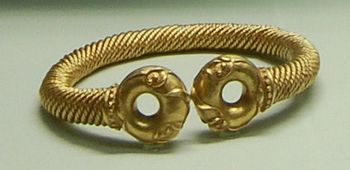Newark Torc facts for kids
Quick facts for kids The Newark Torc |
|
|---|---|
 |
|
| Material | Gold |
| Created | 200 BC–50 BC |
| Period/culture | Iron Age, La Tène |
| Place | Newark-on-Trent |
| Present location | National Civil War Centre, Newark |
The Newark Torc is a very special piece of ancient jewelry. It is a large, golden necklace called a torc. Someone found it with a metal detector near Newark-on-Trent, Nottinghamshire, England, in February 2005. This amazing treasure is from the Iron Age, a time long ago in history.
Contents
Discovering the Newark Torc
The Newark Torc was found by Maurice Richardson. He was a tree surgeon who enjoyed metal detecting. He found the torc while searching in a field. The torc was buried in a pit. This means it was likely hidden on purpose, not just lost. Experts think it might have been an offering to ancient gods.
What is a Torc?
A torc is a stiff neck-ring or arm-ring. People wore them in ancient times. They were especially popular during the Iron Age. Torcs were often made from twisted metal. They showed a person's wealth or status.
How the Newark Torc Was Made
The Newark Torc is made from a special metal called electrum. Electrum is a natural mix of gold, silver, and a little copper. This torc weighs about 700 grams (1.5 pounds). It is 20 centimeters (about 8 inches) across.
The main part of the torc is made from thin gold wires. These wires were rolled and then braided. They were woven into eight thin ropes. These ropes were then twisted together. The ends of the torc are ring-shaped. They have beautiful flower and dot designs.
Where Did It Come From?
Experts believe the Newark Torc was probably made in Norfolk, England. It looks very similar to another torc found in Sedgeford, Norfolk. Some experts even think the same skilled artist might have made both torcs.
The Torc's Age and Importance
The Newark Torc was made between 250 and 50 BC. It was likely buried around 75 BC. This makes it a very old and important discovery. Jeremy Hill, a top researcher at the British Museum, called it amazing. He said it shows incredible skill in metalwork and art. He believes it is one of the most important finds of Iron Age Celtic gold jewelry in the last 50 years.
What is Treasure Trove?
In 2005, the Newark Torc was declared "treasure trove". This is a legal term for old, valuable items found hidden. If something is treasure trove, the Crown (the government) has a right to it. However, museums can buy these items. This helps keep them safe for everyone to see.
The Newark Torc was bought in 2006. It is now kept at Newark's Millgate Museum. The National Heritage Memorial Fund helped a lot with the money to buy it. This means many people can now visit and learn about this ancient treasure.
Images for kids


